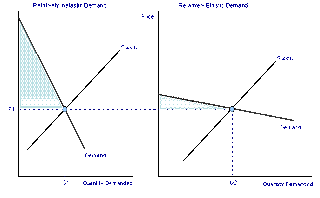Sometimes we pay more than we actually needed to pay due to satisfaction. For example, LALA loves spaghetti and for her first spaghetti dish she's willing to pay more than the actual amount BECAUSE SHE LOVES THE BLOODY SPAGHETTI TOO MUCH. So, after a while she went back to eat her favorite spaghetti. and this time she it's okay with it but still she's willing to pay more. DUE TO HER CRAZY OBSESSION, she went back to the same shop and eat it again. Finally she starts to feel neutral for it because she's bored and tired of the same food everyday. NOW, she only feels like paying the actual amount.
This is a demand diagram showing the consumer surplus
- The part where the consumer is willing to pay is the two region (consumer surplus and total revenue)
- The part where the consumer actually pay is the total revenue
- Lastly, you know where is the consumer surplus as it's stated above.
Getting the consumer surplus is easy: Just use the area of where consumer is willing to pay minus the area where consumers actually pay) :D
THE CONSUMER SURPLUS CAN CHANGE??????
Yes it does. due to the price elasticity of demand! as well as Change is equilibrium price due to shift of demand or supply curve.
Yes it does. due to the price elasticity of demand! as well as Change is equilibrium price due to shift of demand or supply curve.
This shows that as the line gets less "sloppy" the consumer surplus gets lesser!
OKAY. THE PICTURE IS A BIT RETARDED. The left one is when demand curve shift upwards and the right one is when supply curve shift downwards.
- As demand curve shift to the right the consumer surplus increases.
- As supply curve shift to the right the consumer surplus decreases.
INDIRECT TAX
It's the tax on goods and services. INDIRECT TAX SUCH AS AD VALOREM and SPECIFIC TAX.
The way which Ad Valorem Tax works is as prices of goods and services increase, the tax will get higher. For Specific Tax, the tax remains same at any price of the goods and services.
Ad Valorem Tax
Specific Tax
TIME TO EXPLAIN HOW DO TAX WORKS
At first the original price was B and it's selling at H quantity. After specific tax which is $1, the supply curve shift upwards which increase the price from B to C and decrease the QS from H to G. The new equilibrium price will be C and the new quantity will be G. We know that equilibrium has shifted from E to F. Although, AC is equal to the rise of tax $1 but the consumers only have to pay the price BC.Therefore, the producers have to pay some of the tax as well which is the price AB. Why the producer want to do this?? This is because they want to PREVENT the demand on their goods to decrease A LOT. By paying some of the tax will help reduce the consumer's indirect tax by a little. The total revenue earned by the government will be CFDA ( IT'S IN THE QUANTITY OF OG)
SUBSIDIES
Subsidies are financial help given by the government to the producer
which helps reduce the COST OF PRODUCTION
and INCREASE THE QUANTITY SUPPLIED
LASTLY DECREASE THE PRICE of goods
some parts of the price fall is enjoyed by the producers <c.o.p fall> and the other part is enjoyed by the consumers <price decrease>


.gif)

.jpg)
.jpg)

No comments:
Post a Comment